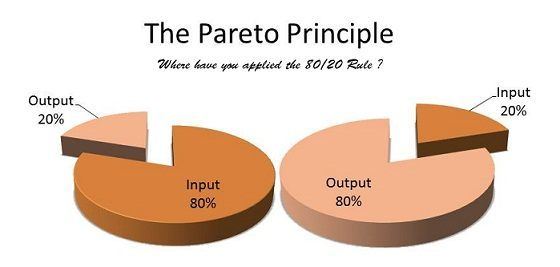
Understanding the Pareto Principle (The 80/20 Rule)
Have you ever heard of the 80/20 Rule? Or maybe you’ve wondered about how this practical rule came about? The 80/20 Rule has many names, including Pareto Rule, Pareto principle or Pareto’s law and it states that roughly 80% of an event’s effects come from 20% of the causes.
This principle was named after the Italian economist, Vilfredo Pareto (1848-1923). Vilfredo observed that 80% of the land in Italy was owned by 20% of the population, 20% of the pea pods in his garden contained 80% of the peas, etc. Although his original observation was in connection with population and wealth, he found after various surveys in other countries, that a similar distribution applied in almost every facet of life.
Vilfredo Pareto created a mathematical formula to describe the unequal distribution of wealth in Italy. Quality Management pioneer, Dr. Joseph Juran, (who worked in the US during the 1930s and 40s) called it the “universal law of vital few and trivial many”.
You can apply the 80/20 Rule to almost anything, all the way from the science of management, to the physical world. Pareto’s Law is commonly used in businesses, because 80% of the sales come from 20% of their clients. This principle can apply to any domain. The United Nations Development Program Reports show that even the distribution of global income follows this law; with the richest 20% of the world’s population controlling about 80% of the world’s income.
Project Managers know that 20% of the work consumes 80% of your time and resources. Business owners know that 20% of the stock not only takes up 80% of the warehouse space, but 80% of the stock comes from 20% of the suppliers.
In the case of Apple Inc., 80% of the sales come from 20% of the sales staff. And 20% of the staff causes 80% of the problems! Still, it works both ways and another 20% of your staff will provide 80% of the production. The value of the Pareto Principle for a manager is that it reminds him to focus on the 20% that are the most productive.
If you think about all the things you do during your day, only 20% really matters, and that 20% produces 80% of your results. In conclusion, you should identify and focus on those things. If something in the schedule has to slip, make sure it’s not part of that 20%.
To be successful, apply the Pareto Principle to all you do in life and work. Pareto’s Principle should serve as a reminder to focus 80% of your time and energy on the 20% of your work that is the most important.
The million-dollar question is, does the value of the time you spent reading this text fall in the 80%, or the 20% category?
See also:
- Apple Encyclopedia: all information about products, electronic devices, operating systems and apps from iGotOffer.com experts.






Facebook
Twitter
RSS